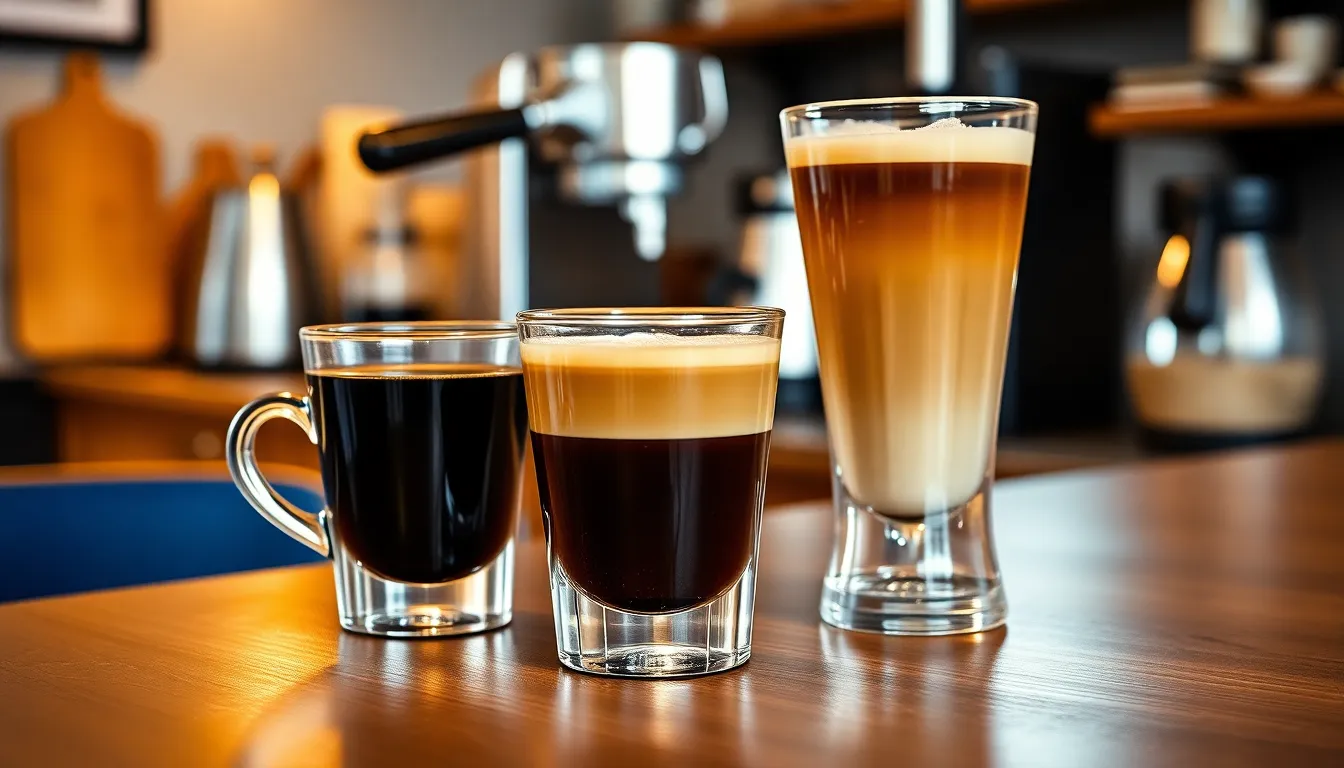Ever wondered about the difference between ristretto, espresso, and lungo? These three coffee variations might seem similar at first peek, but they each offer distinct flavor profiles and brewing techniques that set them apart.
When you order a ristretto, espresso, or lungo, you’re essentially requesting different extraction levels from the same coffee grounds. A ristretto is shorter and more concentrated, while a lungo is longer with more water. The classic espresso sits right in the middle, balancing intensity and volume. Understanding these differences can transform your coffee experience and help you find your perfect cup.
Understanding the Espresso Spectrum
Espresso serves as the foundation for many coffee drinks, yet it’s not a one-size-fits-all concept. The espresso spectrum encompasses three primary variations: ristretto, traditional espresso, and lungo. These variations differ in brewing time, water volume, and extraction rates, resulting in distinct flavor profiles that appeal to different palates.
The Extraction Process Explained
Extraction defines the process of drawing flavors, oils, and compounds from coffee grounds using water. During extraction, water interacts with ground coffee to dissolve soluble compounds that contribute to taste, aroma, and mouthfeel. The espresso extraction timeline releases different compounds at various stages: initial acids and bright notes emerge first, followed by balanced sweetness, and finally bitter compounds.
Coffee extraction percentages significantly impact flavor: under-extracted coffee (below 18%) tastes sour and weak, properly extracted coffee (18-22%) delivers balanced flavors, and over-extracted coffee (above 22%) becomes bitter and astringent. The extraction rate depends on grind size, water temperature, pressure, and contact time—all factors that differentiate ristretto, espresso, and lungo preparations.
Brew Ratio: The Key Differentiator
Brew ratio represents the relationship between the amount of coffee grounds used and the final liquid volume produced. This measurement fundamentally distinguishes ristretto, espresso, and lungo from one another. Standard espresso typically uses a 1:2 ratio (1 part coffee to 2 parts water), resulting in approximately 30ml of liquid from 15g of coffee grounds.
Ristretto employs a more concentrated 1:1 or 1:1.5 ratio, yielding a smaller volume (15-20ml) while using the same amount of coffee. Lungo stretches to a 1:3 or 1:4 ratio, producing 45-60ml of coffee from the standard dose. These ratio differences create the characteristic intensity variations across the espresso spectrum.
Time and Volume Variations
Brewing time directly affects extraction levels across the espresso spectrum. Ristretto shots pull for 15-20 seconds, standard espresso requires 25-30 seconds, and lungo extends to 35-40 seconds. These time differences, combined with varying water volumes, produce distinct coffee experiences.
The final volume in your cup creates immediate visual differences: ristretto appears as a concentrated 15-20ml shot, espresso fills the cup with 25-30ml of crema-topped liquid, and lungo presents as a fuller 45-60ml beverage. According to Rikki Manny, a specialty coffee shop owner, “Customers often express surprise at how dramatically the flavor changes between these three preparations, even though using identical beans and equipment.”
Flavor Profile Differences
Flavor profiles vary dramatically across the espresso spectrum due to extraction differences. Ristretto delivers an intense, sweet-forward experience with prominent fruity acidity and minimal bitterness. The limited water volume extracts primarily the desirable compounds, creating a concentrated flavor bomb that highlights the coffee’s brightest notes.
Traditional espresso achieves balance between acidity, sweetness, and bitterness with medium body and prominent aromatics. The standard extraction time allows for comprehensive flavor development while maintaining harmonious taste elements. Lungo offers a more diluted profile with pronounced bitterness, reduced sweetness, and lighter body due to extended extraction pulling more bitter compounds from the grounds.
What Is a Ristretto: The Concentrated Shot
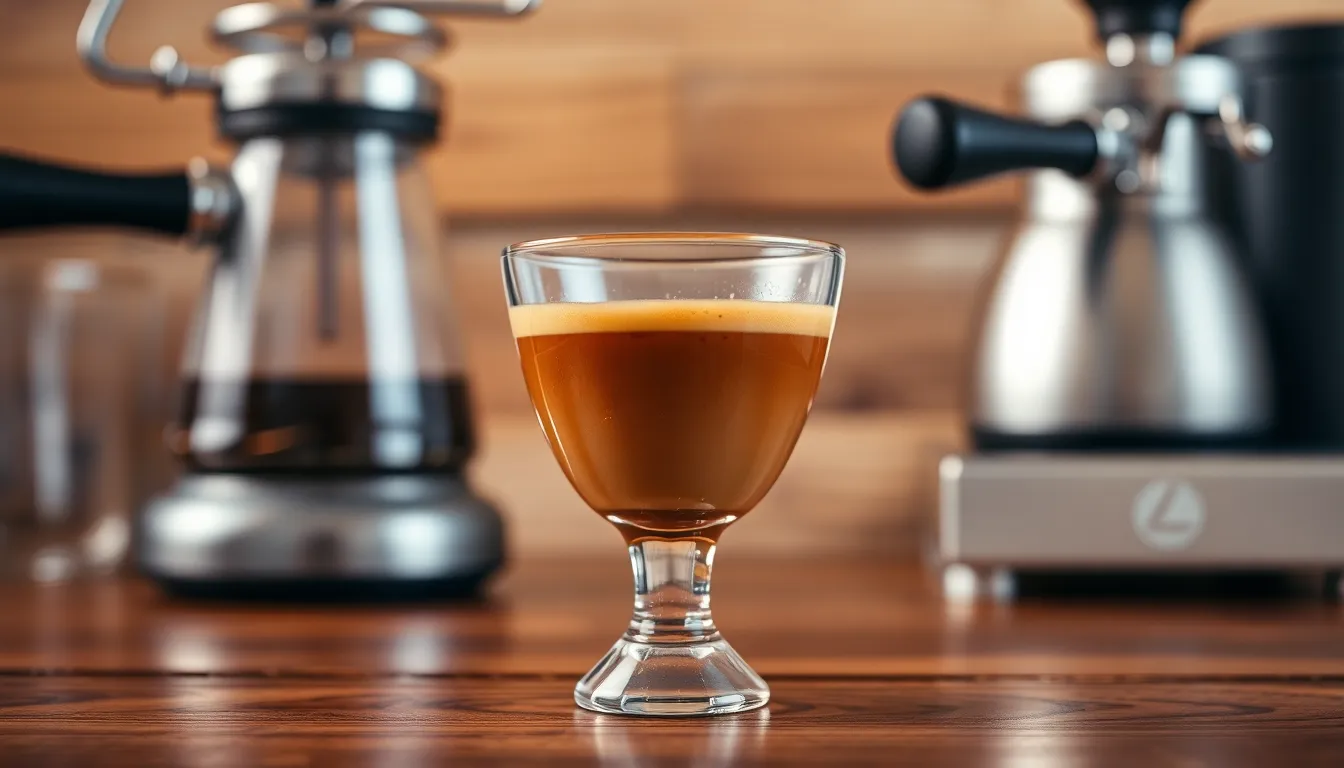
A ristretto is the most concentrated form of espresso, delivering an intense coffee experience in a tiny package. This “restricted” shot (as its Italian name suggests) uses the same amount of coffee grounds as a standard espresso but significantly less water, creating a powerful flavor bomb that coffee enthusiasts cherish.
Ristretto Brewing Method
Brewing a proper ristretto requires precise control over the extraction process to achieve its distinctive concentration. Baristas pull a ristretto with approximately half the water volume used for a standard espresso while maintaining the same amount of coffee grounds, typically creating a 1:1 coffee-to-water ratio compared to espresso’s 1:2 ratio. The coffee grounds are often ground finer than for regular espresso to slow down the water flow, ensuring proper extraction even though the reduced volume. This shortened extraction process takes about 15-20 seconds, stopping before many of the bitter compounds have a chance to dissolve into your cup.
Flavor Profile of Ristretto
Ristretto shots deliver a unique flavor experience characterized by their concentrated intensity and complex aromatics. The shorter extraction highlights the coffee’s bright, fruity, and acidic notes while minimizing bitterness that emerges in longer pulls. Ristrettos feature a distinctly syrupy texture that coats your palate, allowing you to fully appreciate the coffee’s natural sweetness and fragrant qualities. Many coffee connoisseurs prefer ristrettos for their pure expression of coffee’s essential flavors – the first compounds extracted are often the most desirable, creating a sweeter, more aromatic cup compared to traditional espresso or lungo preparations.
The Classic Espresso: Finding Balance
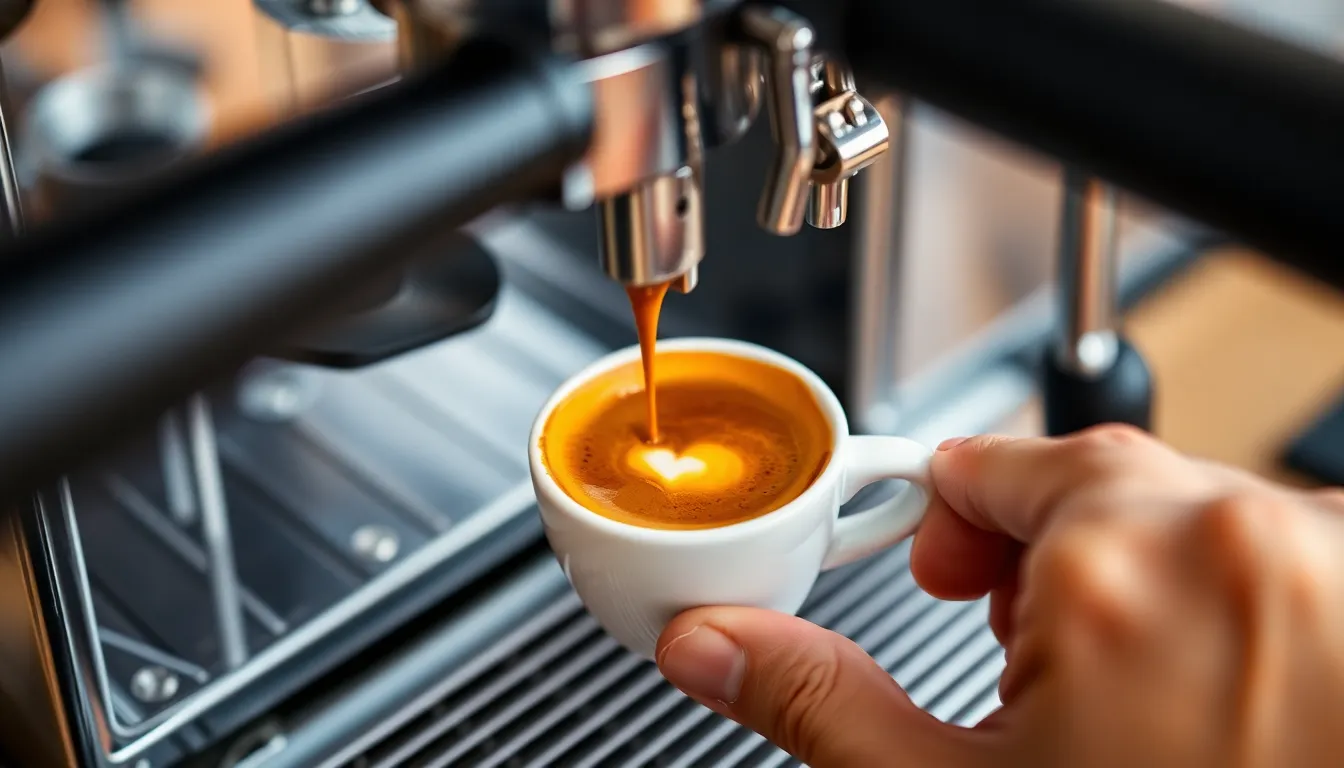
Espresso stands as the quintessential middle ground in the coffee spectrum, offering a harmonious balance of flavors and serving as the foundation for countless coffee beverages. It’s the standard against which ristretto and lungo are measured, with its own distinct preparation methods and taste profile that coffee lovers have cherished for generations.
Standard Espresso Preparation
Espresso preparation involves forcing hot water through finely ground coffee beans at high pressure—typically 9 bars—creating a concentrated shot in 25-30 seconds. The grind size for espresso must be substantially finer than other brewing methods to enable proper extraction during this brief window. A single shot typically uses 7-9 grams of coffee to produce about one ounce (30ml) of liquid, while a double shot requires 14-18 grams. The ideal brew ratio hovers around 1:2, meaning the weight of the extracted coffee is approximately twice the weight of the dry grounds used. This precise ratio contributes to espresso’s signature golden-brown crema—a foamy layer formed by emulsified coffee oils that indicates quality extraction.
Taste Characteristics of Espresso
Espresso delivers a complex flavor profile that balances sweetness, acidity, and bitterness in perfect harmony. The concentrated nature of espresso brings out rich chocolate notes, caramel sweetness, and nutty undertones that create depth without overwhelming the palate. Its creamy texture and medium body provide a satisfying mouthfeel that’s neither too thick nor too thin. The distinctive crema adds another dimension to the experience, offering aromatic compounds that enhance the overall sensory profile. Proper extraction is critical—under-extracted espresso tastes sour and weak, while over-extraction produces excessive bitterness. The balanced flavor of a well-crafted espresso makes it versatile enough to enjoy on its own or serve as the foundation for milk-based drinks like cappuccinos and lattes.
Lungo: The Extended Extraction
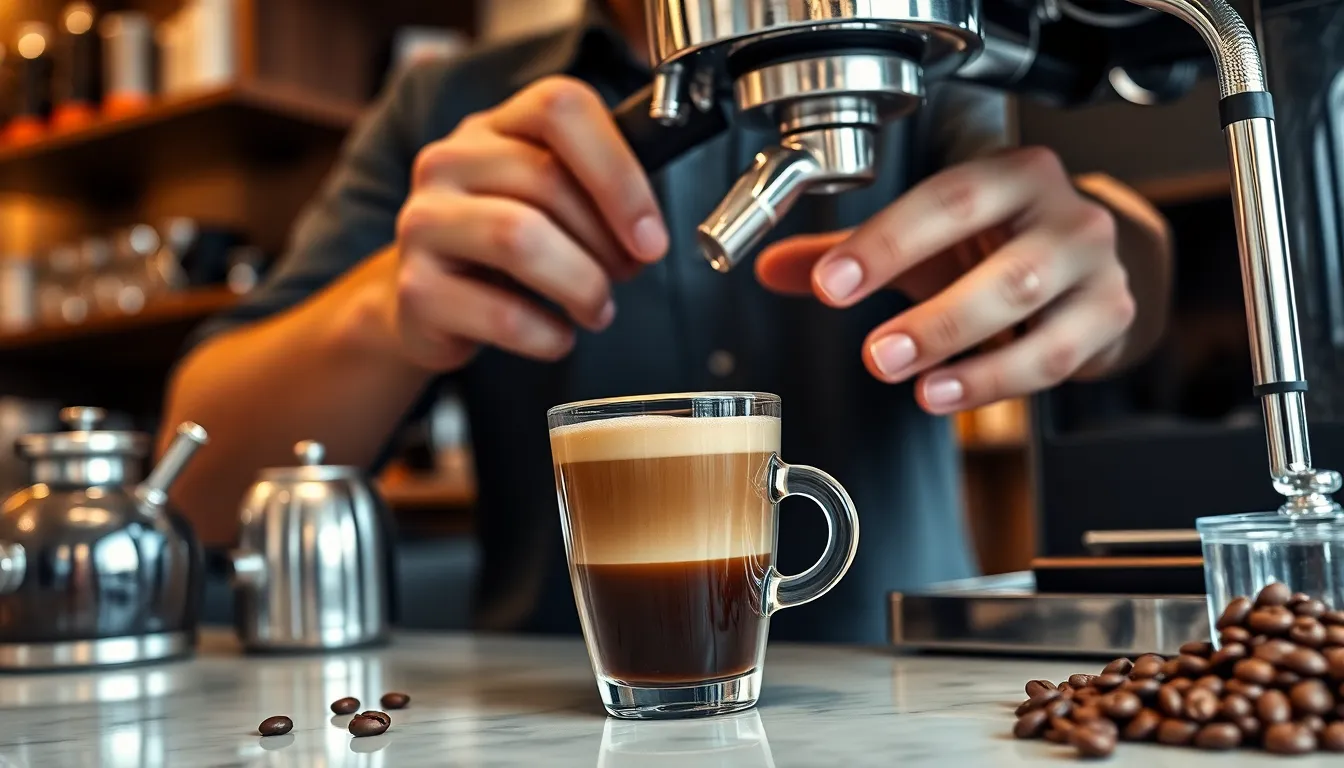
Lungo represents the longest extraction on the espresso spectrum, using twice the water volume of a standard espresso shot while maintaining the same coffee grounds. This extended brewing method creates a distinctly different coffee experience that appeals to those seeking a milder yet more voluminous espresso-based drink.
How Lungo Is Made
Lungo preparation involves running significantly more water through the coffee grounds than a standard espresso shot. Baristas typically use about 80 grams of liquid for a double lungo compared to just 40 grams for a double espresso. The brewing process maintains the same coffee dose in the portafilter but extends the extraction time considerably. Water continues to flow through the grounds for 35-40 seconds, nearly twice as long as a ristretto extraction. This prolonged contact with water allows for a more thorough extraction of coffee compounds, including those that emerge later in the brewing process. The standard lungo brew ratio sits at approximately 1:3 or 1:4, creating a larger serving size that fills more of the cup than its concentrated counterparts.
Lungo’s Unique Flavor Notes
Lungo’s flavor profile stands in stark contrast to both ristretto and standard espresso. The extended extraction produces a milder intensity but introduces more pronounced bitterness due to the additional compounds drawn out during the longer brewing time. Lungo offers a thinner body and lighter texture than its concentrated counterparts, with reduced sweetness and acidity that would typically dominate in ristretto shots. The coffee’s natural caramel notes become more subdued while woody and herbal elements gain prominence. Many coffee enthusiasts appreciate lungo for its approachable volume that doesn’t require dilution with additional water. The resulting cup delivers a distinctive coffee experience that maintains espresso’s fundamental character while presenting a different balance of flavors—less sweet and intense than ristretto or standard espresso, but with a complexity that comes from its comprehensive extraction of diverse coffee compounds.
Key Differences in Caffeine Content and Strength
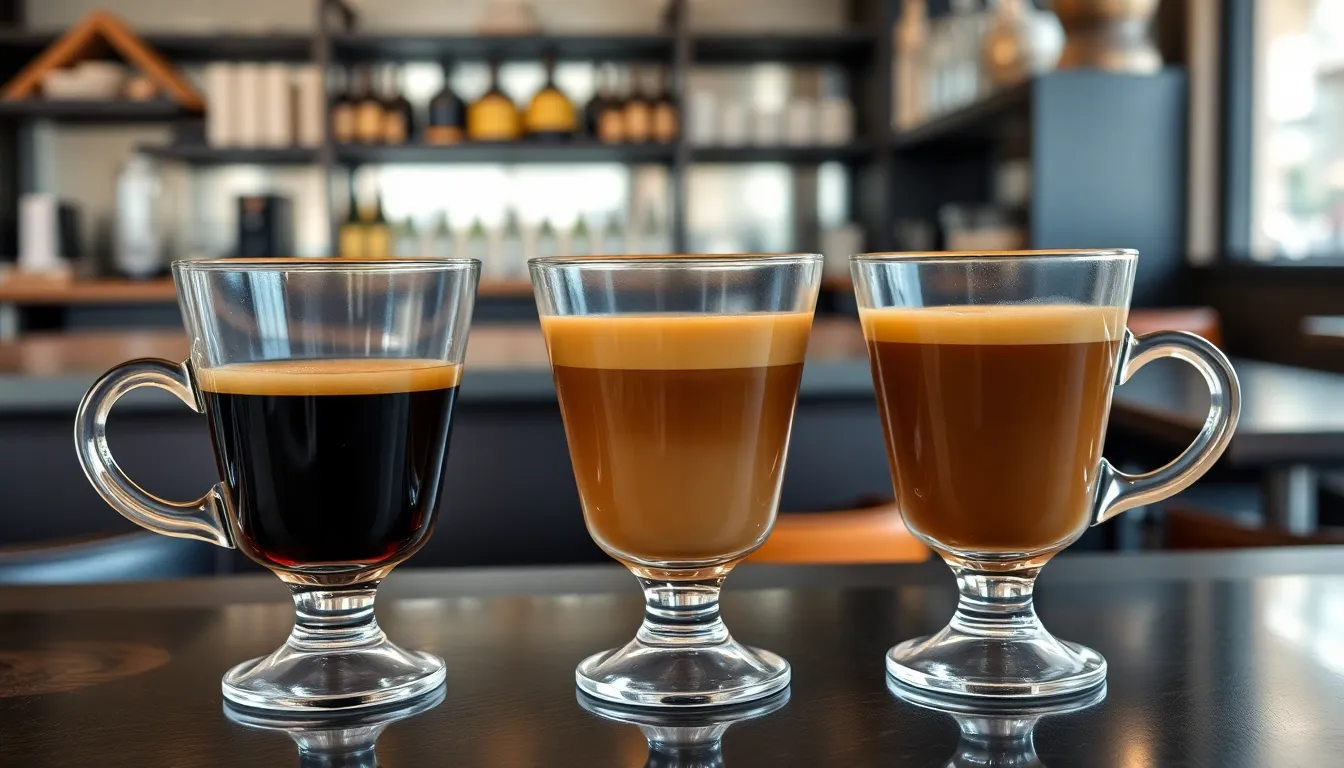
Ristretto, espresso, and lungo share the same coffee foundation but differ dramatically in their caffeine content and overall strength due to variations in water volume and extraction time. These differences create distinct experiences for coffee enthusiasts seeking either intensity or volume in their espresso drinks.
Brewing Parameters and Flavor Profiles
| Parameter | Ristretto | Espresso | Lungo |
|---|---|---|---|
| Coffee to water ratio | 1:1 to 1:1.5 | 1:1.5 to 1:2.5 | 1:2.5 to 1:4 |
| Extraction time (sec) | ~15–20 | ~25–30 | ~40–50 |
| Coffee dose (g) | 18 | 18 | 18 |
| Yield (g) | ~18–27 | ~27–45 | ~45–72 |
| Grind size | Finer than espresso | Fine | Slightly coarser |
| Body | Syrupy, dense | Balanced | Light-bodied |
| Flavor profile | Sweet, bold, low bitterness | Rich, smooth, slight acidity | Aromatic, slightly bitter, clean finish |
Ristretto delivers a concentrated, syrupy experience with pronounced sweetness and minimal bitterness due to its restricted water flow. Espresso provides the classic balance between acidity, sweetness, and subtle bitterness that’s become the standard for coffee bars worldwide. Lungo offers a more diluted experience with a lighter body but often presents more bitterness and a cleaner finish thanks to its extended extraction process.
Caffeine Content Comparison
Ristretto contains less total caffeine even though its intense flavor profile because caffeine compounds extract later in the brewing process. The shorter extraction time (15-20 seconds) means ristretto pulls primarily the initial compounds responsible for sweetness and aromatics but misses some caffeine that would extract with longer contact.
Espresso extracts for a moderate duration (25-30 seconds), allowing for a balanced caffeine profile that captures most of the available compounds without over-extraction. This middle-ground approach delivers the benchmark caffeine content against which other espresso variations are measured.
Lungo potentially contains more total caffeine than both ristretto and espresso due to its extended extraction time (40-50 seconds). The longer water contact allows for more complete caffeine extraction, though the higher water volume dilutes the concentration per ounce. Coffee professionals debate whether the extended extraction truly yields more caffeine or if the dilution offsets any potential gains.
Your perception of strength might not align with actual caffeine content when comparing these three variations. Ristretto feels more intense due to its concentrated flavor compounds, yet contains less caffeine by volume than a lungo. The bitter notes in lungo might create an impression of strength, while in reality, this bitterness comes from over-extracted compounds rather than caffeine itself.
Choosing the Right Shot for Different Coffee Drinks
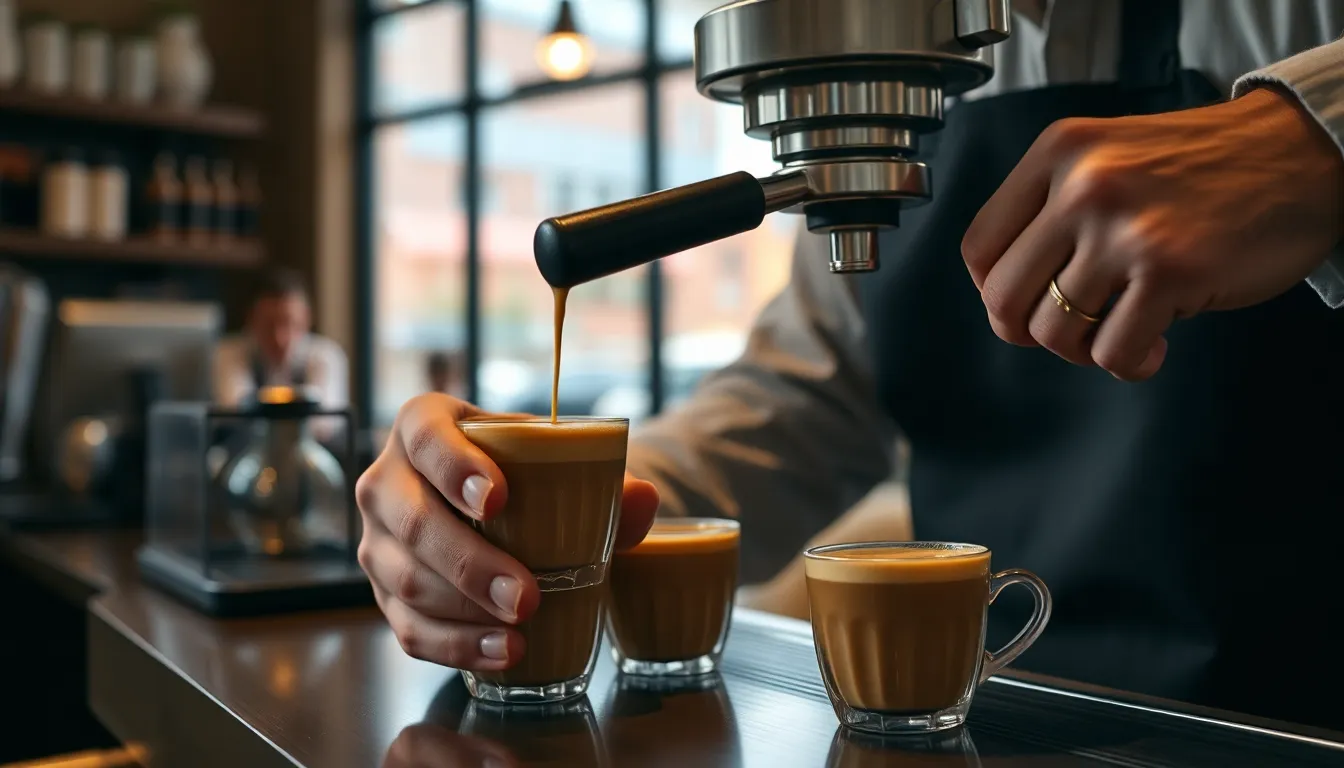
For Morning Energy Boosts
Espresso shots provide the perfect morning pick-me-up with their balanced flavor profile and moderate caffeine content. Their 30-40ml volume delivers a quick energy boost without overwhelming your palate. Many coffee enthusiasts prefer starting their day with a doppio (double espresso) for maximum morning effectiveness, especially when paired with a light breakfast.
For Milk-Based Beverages
Ristretto shots excel in milk-based drinks like cappuccinos and lattes. The concentrated 15-20ml shot cuts through milk more effectively than other variations, maintaining coffee’s distinctive character even when combined with steamed milk. Baristas often select ristretto for specialty milk drinks because its intense sweetness complements the creamy texture without getting lost.
For Afternoon Enjoyment
Lungo shots work beautifully for afternoon coffee breaks when you’re looking for a more leisurely experience. Their larger 60-80ml volume feels more substantial in the cup while offering a gentler flavor profile. Lungo’s milder intensity makes it perfect for sipping slowly during mid-day breaks without the overwhelming boldness of more concentrated options.
For Specialty Drinks
Different espresso variations shine in exact specialty drinks. Ristretto’s concentrated profile forms the foundation for a perfect flat white, allowing the coffee flavor to remain prominent even though the milk addition. Espresso creates balanced classics like americanos and macchiatos. Lungo serves as an excellent base for coffee cocktails where its larger volume and distinct bitterness complement additional ingredients.
For Different Flavor Preferences
Your personal taste preferences determine which shot works best for you. Ristretto appeals to those seeking intense sweetness with bright, fruity notes and minimal bitterness. Espresso satisfies coffee purists looking for the classic balance of chocolate notes, caramel sweetness, and nutty undertones. Lungo attracts coffee drinkers who appreciate a more diluted experience with pronounced bitterness and a larger volume to enjoy.
For Coffee Bean Exploration
Different extraction methods highlight various aspects of coffee beans. Ristretto emphasizes a bean’s sweetness and acidity, making it ideal for fruity single-origin coffees from Ethiopia or Kenya. Espresso brings out balanced characteristics in most beans, working wonderfully with medium-dark roasts. Lungo extracts more compounds from the beans, making it particularly interesting for exploring complex dark roasts where extended extraction reveals deeper flavor layers.
Which Shot Should You Order? Matching to Your Taste
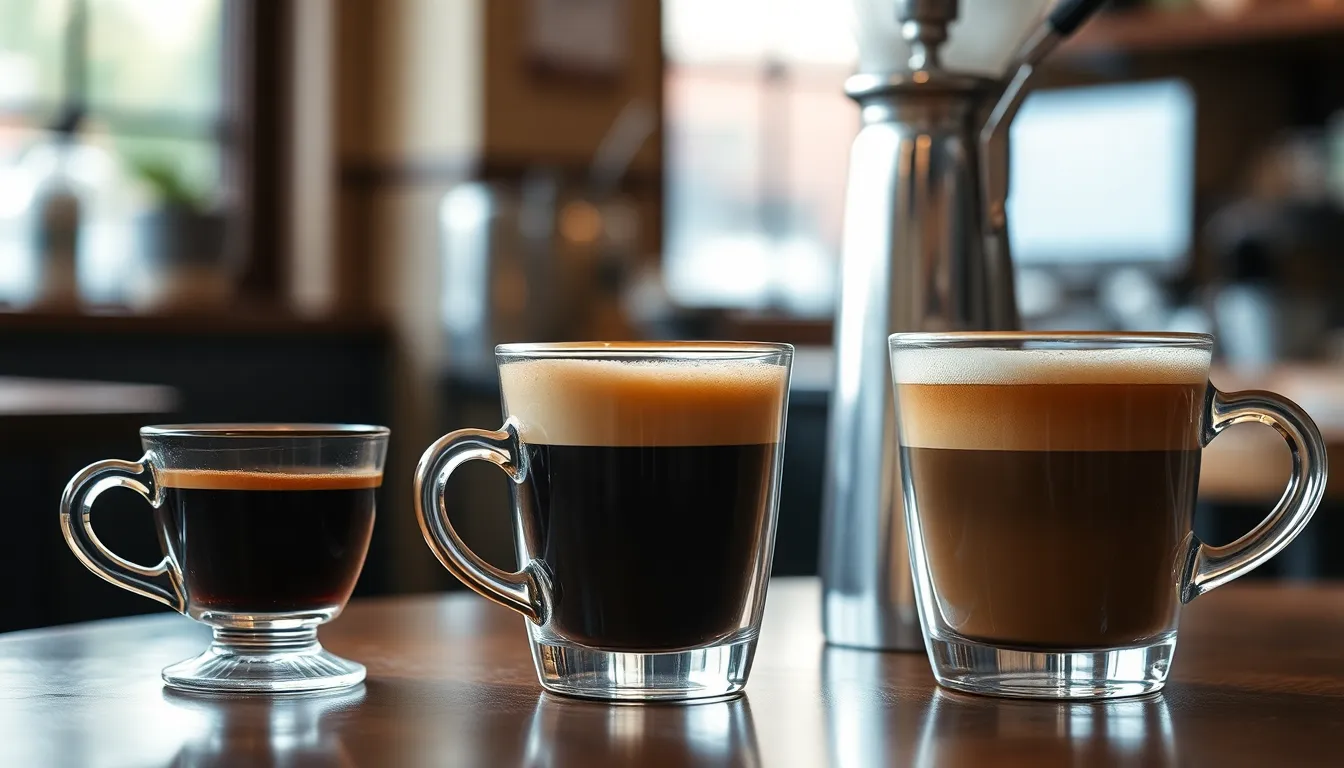
For bold intensity lovers, a ristretto delivers an unmatched coffee experience. This concentrated shot uses a tight 1:1 to 1:1.5 coffee-to-water ratio, creating a syrupy texture with intense flavors. Ristretto captures the brightest, sweetest notes from coffee beans while minimizing bitterness. You’ll taste a rich, dark profile that’s perfect for those who appreciate coffee’s full-bodied potential.
For balanced flavor seekers, a standard espresso shot offers the quintessential coffee experience. With its 1:2 to 1:3 brew ratio, espresso strikes a perfect harmony between acidity, bitterness, and body. Your typical double shot uses about 18 grams of coffee to yield 36 grams of liquid, extracted in 25-30 seconds. This creates the classic espresso profile that’s versatile enough to enjoy straight or as a foundation for other drinks.
For milder coffee enthusiasts, lungo provides a gentler approach to espresso. The extended brewing process uses more water than standard espresso, resulting in a larger volume with less concentration. Lungo maintains espresso’s fundamental character but presents a different flavor balance—often more bitter but less intense overall. Your coffee experience becomes more nuanced, similar to an Americano but with distinctive espresso qualities.
Taste preferences eventually determine which shot works best for you—ristretto for concentrated boldness, espresso for balanced richness, or lungo for a milder, extended coffee experience.
Conclusion
The industry of espresso offers a spectrum of experiences that cater to every palate. Whether you prefer the concentrated sweetness of a ristretto the balanced complexity of a traditional espresso or the milder intensity of a lungo each variation provides a unique coffee journey.
By understanding the differences in brew ratios extraction times and flavor profiles you can better appreciate the nuances in your cup and make more informed choices at your favorite café. These variations aren’t simply different sizes but rather distinct interpretations of what coffee can be.
Next time you order consider how the brewing method might highlight different aspects of your favorite beans. Your perfect coffee might be hiding in a variation you haven’t yet explored.
Frequently Asked Questions
What is the main difference between ristretto, espresso, and lungo?
Ristretto, espresso, and lungo differ in water volume and extraction time. Ristretto uses less water (1:1 ratio) and is extracted for 15-20 seconds, creating a concentrated, sweeter shot. Espresso uses a balanced 1:2 ratio with 25-30 seconds extraction, offering harmony between sweetness and bitterness. Lungo uses twice the water (1:3 or 1:4 ratio) and extracts for 35-40 seconds, resulting in a more diluted, bitter flavor profile.
Which coffee variation has the most caffeine?
Contrary to what many believe, lungo typically contains more total caffeine than espresso or ristretto due to its longer extraction time, which pulls more caffeine from the grounds. However, per ounce, ristretto is more concentrated. The difference isn’t substantial enough to base your choice solely on caffeine content, as the flavor profile should be your primary consideration.
What does ristretto taste like compared to regular espresso?
Ristretto offers a more intense, sweeter flavor profile than regular espresso. It extracts primarily the first compounds from coffee grounds, capturing bright, fruity notes and natural sweetness while minimizing bitterness. Its syrupy texture enhances the sensory experience. Ristretto highlights the coffee’s best qualities in a concentrated form, making it ideal for those who appreciate bold, sweet coffee flavors.
How long does it take to brew each type of coffee shot?
Brewing times vary significantly across these coffee variations. A ristretto shot pulls for approximately 15-20 seconds, creating a quick, concentrated extraction. Standard espresso requires 25-30 seconds for optimal flavor balance. Lungo takes the longest at 35-40 seconds, allowing more water to pass through the grounds. These precise timing differences are crucial for achieving the distinctive flavor profile of each variation.
Which coffee variation is best for beginners?
Espresso is generally best for coffee beginners as it offers a balanced flavor profile that showcases coffee’s essential characteristics without overwhelming intensity. Its 1:2 ratio creates harmony between sweetness, acidity, and bitterness. For those transitioning from milk-based drinks, lungo might be more approachable due to its milder concentration, while ristretto’s intensity might be better appreciated after developing a coffee palate.
Can you use any coffee beans for ristretto, espresso, and lungo?
While you can use any coffee beans, certain roasts better complement each variation. Medium to dark roasts work well for all three but showcase different characteristics. For ristretto, beans with natural sweetness and chocolate notes shine through the concentrated extraction. Espresso benefits from versatile, balanced beans. Lungo performs better with beans that maintain pleasant flavors during longer extraction without becoming overly bitter.
Do coffee shops charge differently for ristretto, espresso, and lungo?
Most specialty coffee shops charge the same price for ristretto, espresso, and lungo since they use identical amounts of coffee grounds. The difference lies in water volume and extraction time, not ingredient cost. However, some establishments may charge slightly more for ristretto due to its specialty nature or lungo for its larger volume. Always check the menu for specific pricing.
Which is better for making milk-based drinks like lattes?
Ristretto is often preferred for milk-based drinks because its concentrated, sweet flavor profile cuts through milk more effectively than espresso or lungo. Its intensity maintains the coffee character even when diluted with substantial amounts of milk. Many specialty cafés use ristretto shots in cappuccinos and lattes to create a more distinctive flavor profile with enhanced sweetness and reduced bitterness.
How do I order these variations at a coffee shop?
Simply ask for a “ristretto,” “espresso,” or “lungo” at specialty coffee shops. If the barista seems unfamiliar, you can specify: “I’d like an espresso but shorter/with less water” for ristretto, or “an espresso but longer/with more water” for lungo. Quality-focused cafés will understand these terms, though chain establishments might require more explanation about the extraction style you prefer.
Can I make ristretto, espresso, and lungo at home?
Yes, you can make all three variations at home with an espresso machine that allows pressure and volume control. For ristretto, use the same grounds as espresso but extract only 15-20ml of liquid. For espresso, aim for 25-30ml from the same grounds. For lungo, extract 45-60ml. Home machines with programmable buttons make this process simpler, allowing you to customize extraction times and volumes to your preference.

